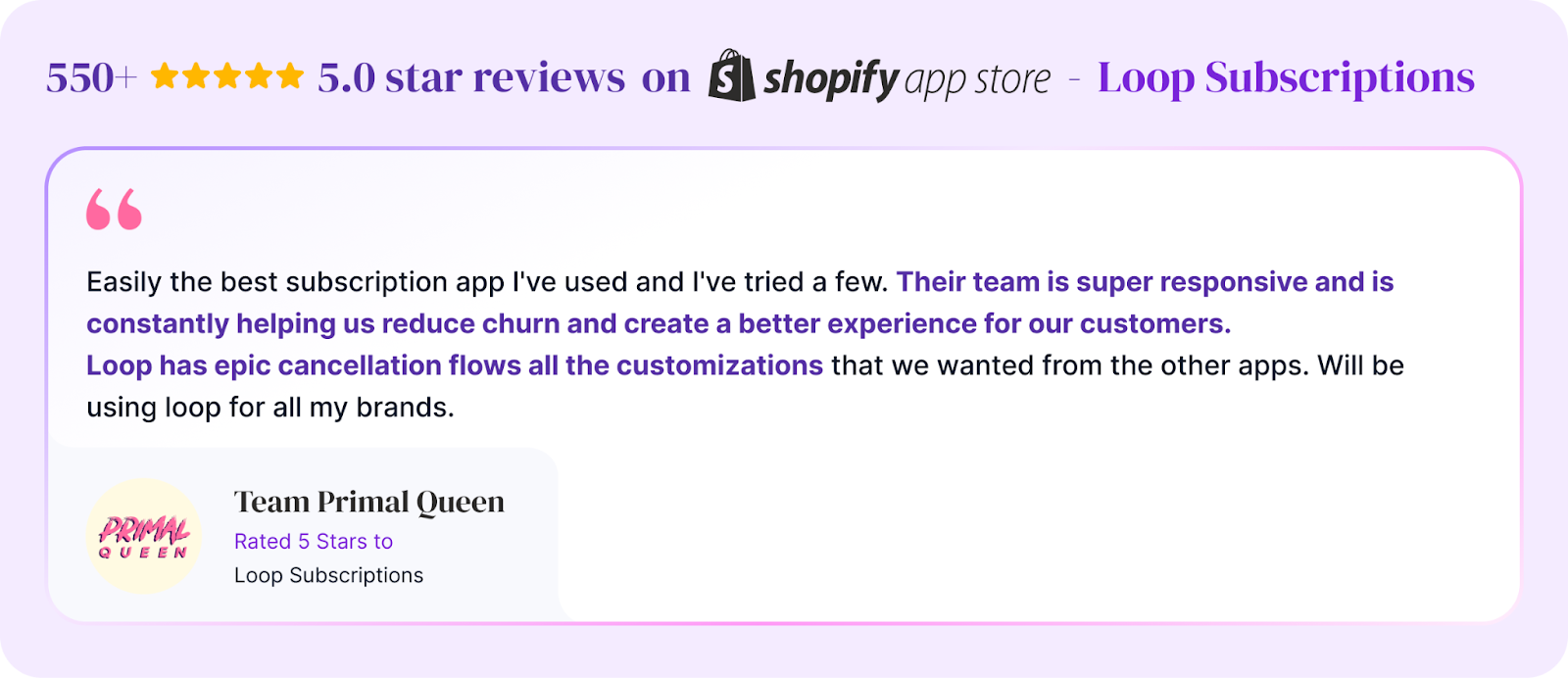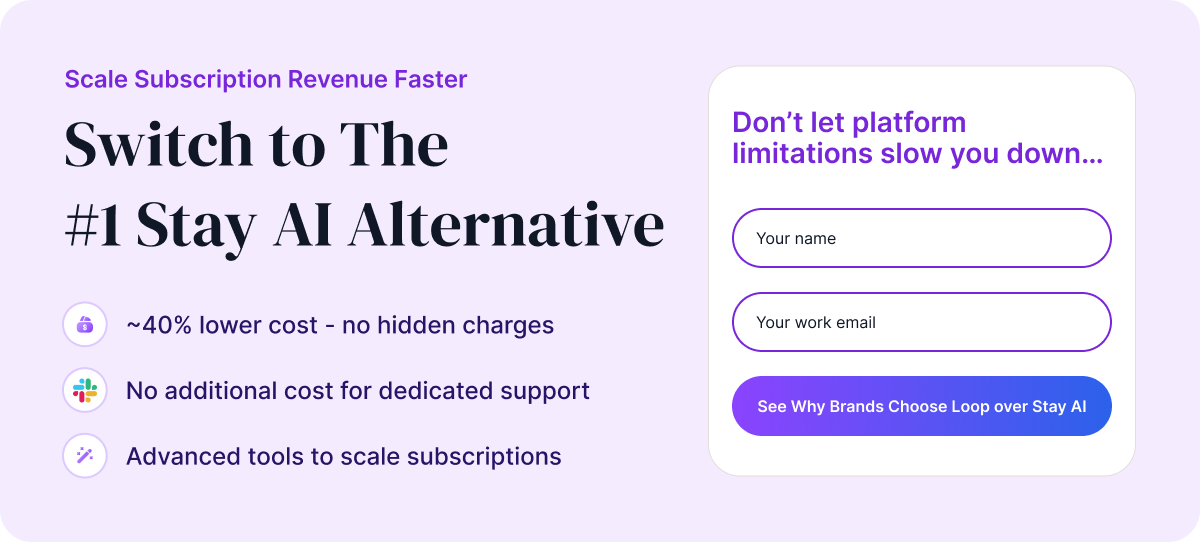Is Stay AI the Best Option for Brands Looking to Scale Subscriptions? (2025)
The Question Brands Should Ask Early On
Here's a common scenario: You launch subscriptions on Stay AI. Everything works as expected—subscribers are billing, the portal is set up, and the cancel flows help reduce churn. The launch is successful.
Then, six months later, you're experiencing higher order volumes, and a few challenges start to emerge. Your CX team is dealing with a growing number of "how do I skip?" tickets. You find it difficult to identify which order numbers are contributing most to churn. Your portal settings reset unexpectedly during a busy period. Support escalations take longer than needed.
The question isn't "Is Stay AI working for us?"—it’s "Is this platform the right choice for scaling as we grow?"
For growing brands, it's not just about having cancel flows; it’s about how customizable and measurable those flows are as your order volumes increase. Loop Subscriptions helps teams reduce support burden with data-backed save journeys that scale efficiently. This guide helps you evaluate whether your platform will continue to meet your needs as you scale.
The 8-Question Scale Evaluation Framework
Use this diagnostic to evaluate your platform before scaling. These are not just "Stay AI vs. Loop" questions—they’re about assessing whether your platform is suited for your growth trajectory.
Q1: Portal Friction Test
"As our order volume increases, will our portal create more support tickets or fewer?"
What to look for:
- Pre-authenticated links from emails (subscribers click "Skip" → action happens, no login/OTP).
- One-click actions (skip/swap/gift in portal without multi-page navigation).
- Dynamic content by subscriber cohort (order #2 vs. order #10 sees different messaging).
Red flag: Multi-step navigation, OTP requirements, generic experience for all subscribers
Why it matters at scale: At higher order volumes, if a large percentage of subscribers contact support about portal navigation, it can lead to a significant increase in support tickets, impacting both customer satisfaction and operational efficiency.
Q2: Churn Diagnostic Test
"Can we identify which specific order numbers have the highest churn, broken down by product and billing frequency?"
What to look for:
- Order-level behavioral dashboard (see % skip/pause/cancel at order #1, #2, #3...#12+)
- Cohort comparison (Product A vs. B subscribers, monthly vs. quarterly billing)
- Revenue impact view (dollar value of churn by order number, not just %)
Red flag: Aggregate churn % only, no drill-down by segment or order number
Why it matters: Being able to see churn by order number allows you to implement specific retention tactics. Without this data, you might miss opportunities to reduce churn at key points in the customer journey.
Q3: Cancel Flow Precision Test
"Can we show different cancel videos and offers to order #2 vs. order #10 subscribers?"
What to look for:
- Profile-based benefits pages (different videos by order count, LTV, SKU)
- Conditional offer logic (10+ order subscribers see 25% discount, 2-order subscribers see pause option)
- Step-level analytics (save rate at video stage, reason stage, offer stage)
Red flag: One-size-fits-all video + generic discount for everyone
Why it matters: Tailoring the offer based on order count or LTV can help preserve margin and ensure more subscribers are retained with the right offer. A generic offer may not be as effective.
Q4: Dunning Recovery Test
"What's our payment recovery rate, and can we store backup payment methods?"
What to look for:
40-70% recovery rate: Many subscription businesses report recovery rates in this range. Brands with optimized dunning processes can achieve even higher recovery rates, often exceeding 70% for top performers.
- Backup card capture: Allow subscribers to store a second payment method, ensuring automatic failover if the primary card fails.
- Pre-failure alerts: Notify customers about upcoming card expirations 30, 15, and 7 days before their card expires, encouraging them to update payment details.
- One-click card updates: Provide a seamless update process in the portal, without redirecting users to external sites (e.g., Shopify).
Red flag:
- Significantly low recovery rates (e.g., below ~40%), lack of backup payment capture, or reliance on external redirects for card updates. These factors can lead to missed recovery opportunities.
Why it matters:
Payment failures are common in subscription models, and optimizing recovery rates can substantially boost retention and revenue. The difference between a 30% recovery rate and a 50% recovery rate can lead to significant revenue growth, potentially recovering hundreds of thousands of dollars annually. Loop Subscriptions reports 90%+ payment recovery with its advanced retry logic (learn more about Loop's payment recovery features here).
Q5: Configuration Stability Test
"What happens to our custom portal settings when the vendor pushes platform updates?"
What to look for:
- Configurations persist through updates (no resets)
- Opt-in update model (you test in staging before applying to production)
- Rollback capability (if update breaks something, vendor can revert immediately)
Red flag: Configurations reset without warning, merchant-reported portal bugs after updates
Why it matters: Unexpected resets or bugs, especially during peak times like BFCM, can cause significant disruptions to operations. It’s crucial to ensure your platform can maintain configurations through updates.
Q6: Support Tempo Test
"If our portal breaks at 8 AM ET during peak fulfillment week, when do we get help?"
What to look for:
- < 30‑minute first response time (e.g., Loop Subscriptions reports “average response time under 30 minutes”). Learn more
- Real-time access (Slack or equivalent, not just email tickets)
- CSM aligned to your time zone (East Coast brands get East Coast CSMs)
Red flag: Email-only support, next-day escalations, time-zone misalignment (Pacific AM for East Coast brand)
Why it matters: At high order volumes, any unresolved technical issue can escalate quickly and impact customer satisfaction, making quick and responsive support essential.
Q7: Economic Scaling Test
"At 2x and 5x our current volume, does our per-order cost go up, stay flat, or go down?"
What to look for:
- Transparent pricing with no per‑order fee (Loop Subscriptions lists “0¢ per order” on their pricing page)
- Volume‑friendly transaction fee (e.g., Loop Subscription’s “0.75% + 0¢ per order” plan)
- Volume discounts (pricing improves as you scale, not penalizes you)
Red flag: Per-order fees, unpredictable add-ons, feature gates at higher tiers
Why it matters: As your order volume increases, per-order fees can significantly increase your overall costs. A transparent pricing model that rewards scaling is key for sustainable growth.
Q8: Feature Roadmap Test
"Are retention features (analytics, flows, dunning, upsells) included or sold separately as we scale?"
What to look for:
- Bundled features in base plans (no "Pro-only" gates on core retention tools)
- Future features included (you're not re-negotiating contracts for new releases)
Red flag: Core retention tools require plan upgrades or add-on purchases
Why it matters: If essential features like profile-based cancel flows, backup payment capture, or order-level analytics require additional costs, it can quickly lead to unforeseen expenses as your business scales.
Your Score:
- 6-8 green flags: Platform can scale with you
- 3-5 green flags: Evaluate alternatives now (before you hit ceiling)
- 0-2 green flags: You'll re-platform within 12 months
Where Stay AI Hits Scalability Ceilings (The Honest Diagnosis)
Evaluating Stay AI using the 8-question framework can reveal potential scalability issues for subscription brands looking to grow. Below is an honest analysis of Stay AI’s capabilities and potential limitations.
Q1: Portal Friction Test
Claim: Merchants report significant support tickets related to "how do I skip?" or other portal navigation issues.
- Fact: Stay AI offers one-click actions like "skip", "swap", and "pause" in the portal to minimize friction and reduce support tickets. However, merchants with higher order volumes or more complex subscription models might experience increased portal friction. This could lead to higher support ticket volumes if subscribers struggle with navigation or updating payment methods.
- What to look for: Pre-authenticated links, one-click actions, dynamic content based on order cycle.
- Red Flag: Multi-step navigation and generic experiences that don’t personalize based on subscriber history.
Q2: Churn Diagnostic Test
Claim: Stay AI offers basic order-level churn & cohort analytics — but not drill-downs by Selling Plan, Delivery Frequency, Country, or Reason trends, which Loop Subscriptions provides.
- Fact: Stay AI provides basic order-level churn tracking, allowing brands to view where churn occurs across different billing cycles (e.g., churn after order #1 or #2). However, it does not include advanced segmentation options such as filtering churn by delivery frequency, country, selling plan, or reason-wise trends. These deeper analytics — available in Loop Subscriptions — are essential for diagnosing churn drivers at scale and targeting interventions by cohort.
- What to look for: Order-level churn data, cohort comparison by product and billing frequency.
- Red Flag: Aggregate churn data only, without the ability to drill down to the order or SKU level.
Q3: Cancel Flow Precision Test
Claim: Stay AI’s cancel flow offers a one-size-fits-all solution without the ability to segment by order count, LTV, or product.
- Fact: Stay AI supports a single cancel journey with configurable screens and generic offerings, but does not enable deep profile-based flows by order count, LTV, SKU, or cancellation cause. This limits personalization and reduces save rate potential. Loop Subscriptions allows brands to show different videos, reasons, and offers based on subscriber segment — and track step-level save rates to continuously optimize retention.
- What to look for: Conditional offers based on order cycle, LTV, product type.
- Red Flag: One-size-fits-all cancel flows with no personalized offers.
Q4: Dunning Recovery Test
Claim: Stay AI’s recovery rate is estimated to be between 20‑30%, which is lower than industry standards.
- Fact: Stay AI includes standard automatic retries for failed payments, which supports basic recovery. However, it does not offer pre-failure alerts, backup payment method capture, or direct portal-based card updates that avoid login friction. These capabilities — available in Loop Subscriptions — significantly increase recovery rates and reduce involuntary churn as subscriber volume grows.
- What to look for: Backup payment capture, pre-failure alerts, one-click updates.
- Red Flag: Low recovery rates (e.g., <40%) and reliance on external redirects for payment updates.
Q5: Configuration Stability Test
Claim: Some merchants report that Stay AI’s portal settings reset after platform updates.
- Fact: Stay AI generally maintains configuration stability, but custom settings might occasionally require attention during updates, especially if major platform changes are introduced. No widespread issues have been reported in verified sources, though some merchants might experience disruptions during platform upgrades.
- What to look for: Persistent configurations through updates, rollback options.
- Red Flag: Configurations resetting without warning, manual fixes required post-update.
Q6: Support Tempo Test
Claim: Merchants report delays in support response time, particularly when working with account managers in different time zones.
- Fact: Stay AI provides real-time support and customer success managers (CSMs) to assist merchants. However, response times can vary depending on time zones and the complexity of the issue. Dedicated support teams are generally available, but time-zone misalignment could result in slower resolutions during critical periods.
- What to look for: <30-minute response time, real-time communication tools (Slack, etc.), CSMs in your time zone. Loop Subscriptions provides fast response times and channels like Slack access depending on plan structure. Having support coverage aligned to brand operating hours becomes increasingly important as order volume and operational dependency increase.
- Red Flag: Delayed responses, email-only support, time-zone misalignment.
Q7: Economic Scaling Test
Claim: Stay AI’s pricing model includes per-order fees, which increase operational costs as your business scales.
- Fact: Stay AI offers transparent pricing, with costs starting at around $499/month. However, per-order fees or additional charges for higher transaction volumes could increase operational costs as businesses scale. In contrast, Loop Subscriptions offers a fixed pricing model with no per-order fees, ensuring predictable costs as businesses grow.
- What to look for: Clear pricing with no per-order fee, volume discounts.
- Red Flag: Unpredictable per-order fees or hidden charges.
Q8: Feature Roadmap Test
Claim: Basic features are included, but advanced features like profile-based cancel flows and order-level analytics are not native to Stay AI.
- Fact: Stay AI focuses on delivering core subscription features and a user-friendly experience for early-stage brands. However, more advanced retention tooling — such as profile-based cancel journeys, segmented churn diagnostics, and intelligent dunning — is still developing. Loop Subscriptions prioritizes retention feature depth and includes these enhancements in its product roadmap without requiring plan upgrades.
- What to look for: Bundled core retention features, transparent future roadmap.
- Red Flag: Core retention tools behind paywalls or requiring higher-tier plans.
Your Score:
Stay AI performs well on Q7 (Economic Scaling) and Q6 (Support Tempo) but shows potential limitations in Q2 (Churn Diagnostic), Q3 (Cancel Flow Precision), and Q4 (Dunning Recovery). Brands using Stay AI should assess whether its scalability suits their growth trajectory, particularly if advanced retention and payment recovery features are critical to their long-term strategy.
Overall, Stay AI may work well for smaller or early-stage businesses but could face challenges in handling higher-order volumes, more sophisticated retention strategies, and customization requirements as the business scales. Loop Subscriptions, on the other hand, is designed for growth — delivering advanced retention journeys, proactive dunning intelligence, and analytics that help teams protect revenue and increase subscriber lifetime value at scale.


What High-Volume Brands Actually Need
When you reach higher order volumes, the following capabilities become essential rather than optional:
- A portal that reduces support tickets (e.g., pre‑authenticated links, one‑click actions)
- Order‑level churn diagnostics (so you can see exact inflection points rather than just aggregate churn)
- Profile‑based cancel flows (different journeys by cohort)
- Strong dunning recovery workflows (e.g., backup payment methods, pre‑failure alerts, high recovery rates)
- Configuration stability (so updates don’t reset your portal or settings)
- Real‑time support (e.g., Slack access, <30‑minute response times, aligned time zones)
- A pricing model that rewards scale (e.g., zero per‑order fees)
What You Should Do Next
Run your platform through the 8-question framework. If you scored <3 green flags, you're building on a foundation that won't hold at 2-3x volume.
Read why brands migrate from Stay AI to Loop Subscriptions →
Good Protein migrated from Stay AI to Loop Subscriptions and achieved a 400% subscriber‑base increase in four months while reducing churn significantly. Read their migration story
See the 5 features Stay AI lacks at scale →
Pre-auth links, profile flows, backup payments, order analytics, personalized upsells (to interlink sub blogs)
Compare Stay AI vs. Loop → Transparent framework scoring + feature depth breakdown
Book a feature demo →
Experience live demos of pre-auth links, profile-based flows, backup payments, order-level analytics, and personalized upsells.
FAQs
Q1. How can I evaluate whether Stay AI is the right platform for scaling my subscription business?
To assess if Stay AI is suitable for scaling, use the 8-question framework outlined in the blog. This framework evaluates key areas such as portal friction, churn diagnostics, dunning recovery, and support tempo to determine if Stay AI can meet your growth needs as you scale beyond early-stage operations.
Q2. What are the limitations of Stay AI for high-volume subscription businesses?
Stay AI provides core subscription workflows, but its retention tooling is less suited to high-volume teams. It lacks deeply segmented churn insights, profile-based cancel journeys, step-level save rate tracking, and dunning workflows like backup card fallback and pre-failure alerts. For brands scaling beyond early-stage volume, these gaps can result in higher operational effort and lower revenue retention.
Q3. How does Loop Subscriptions improve upon Stay AI’s cancel flows?
Stay AI enables merchants to configure a single standardized cancel flow with some customization options. Loop Subscriptions expands on this by enabling multiple cancel journeys tailored to subscriber cohorts — for example, different messaging and offers for a second-order subscriber vs. a tenth-order subscriber. This deeper personalization has a measurable impact on save rates and customer lifetime value.
Q4. What is the dunning recovery rate for Stay AI and how does it compare to Loop Subscriptions?
Stay AI's dunning recovery rate is estimated to be 20-30%, while Loop Subscriptions boasts a ~90% payment recovery rate with its advanced retry logic, backup payment capture, and pre-failure alerts. If you're seeing low recovery rates, switching to a more robust dunning solution can significantly improve your revenue retention.
Q5. What are the key features high-volume subscription brands need that Stay AI may lack?
High-volume brands need advanced features such as profile-based cancel flows, order-level churn diagnostics, seamless dunning recovery, and real-time support. Stay AI may not provide the depth of these tools, which are critical for reducing churn, increasing retention, and optimizing growth at larger scales.
Where Stay AI Scores Well (The Fair Assessment)
Before we diagnose gaps, let’s acknowledge where Stay AI delivers:
- Fast time-to-launch: Stay AI offers a quick setup process, typically enabling brands to get up and running swiftly with subscriptions.
- Solid basics: Billing cycles work, the portal is functional and branded, and cancel flows with reason tracking are available. Klaviyo integration is native.
- Pricing transparency: Public pricing starts at ~$499/month, which is competitive for many brands, particularly those in the early stages of growth.
- Early-stage fit: Stay AI is optimized for businesses in the early stages, particularly those with fewer subscribers and simpler product catalogs.
Table of contents























.png)







.png)





.png)





















.png)














